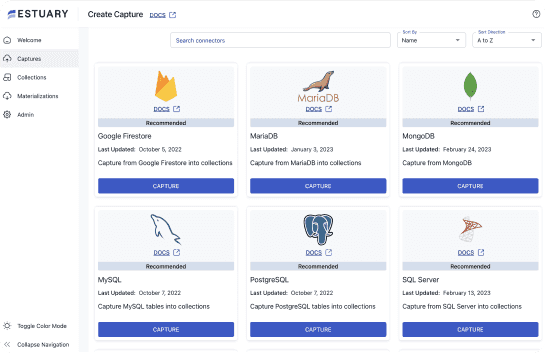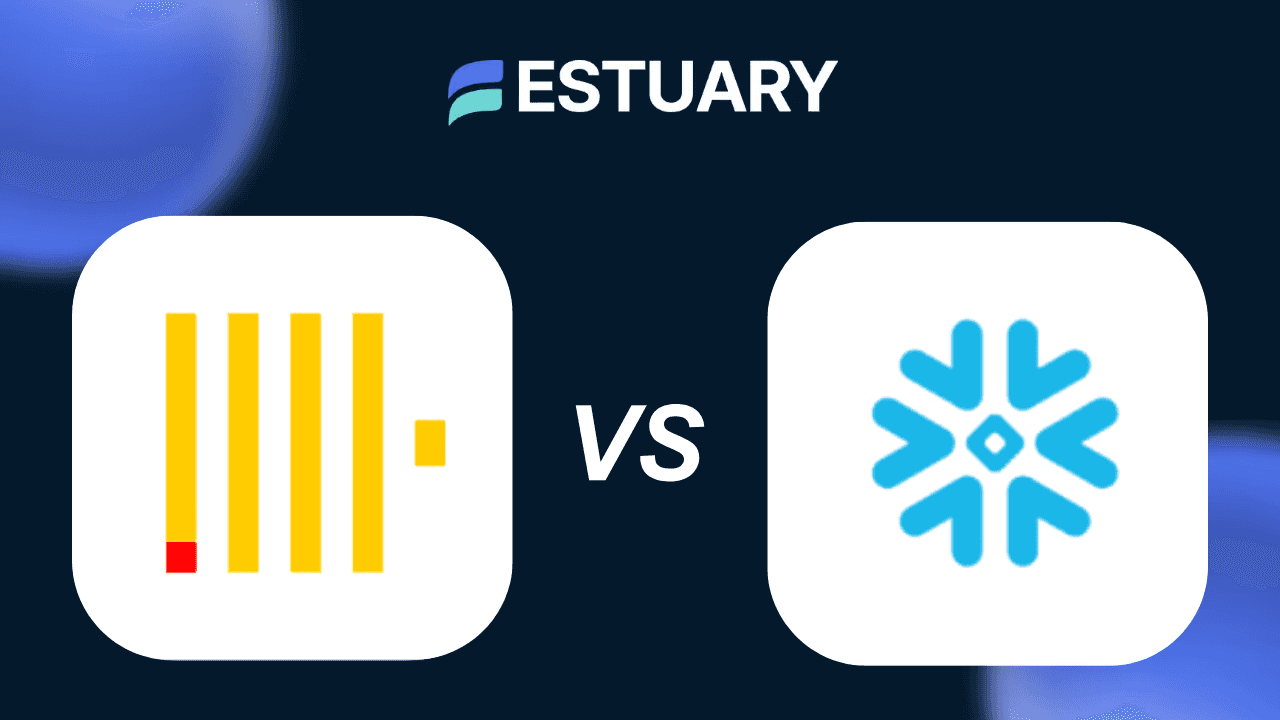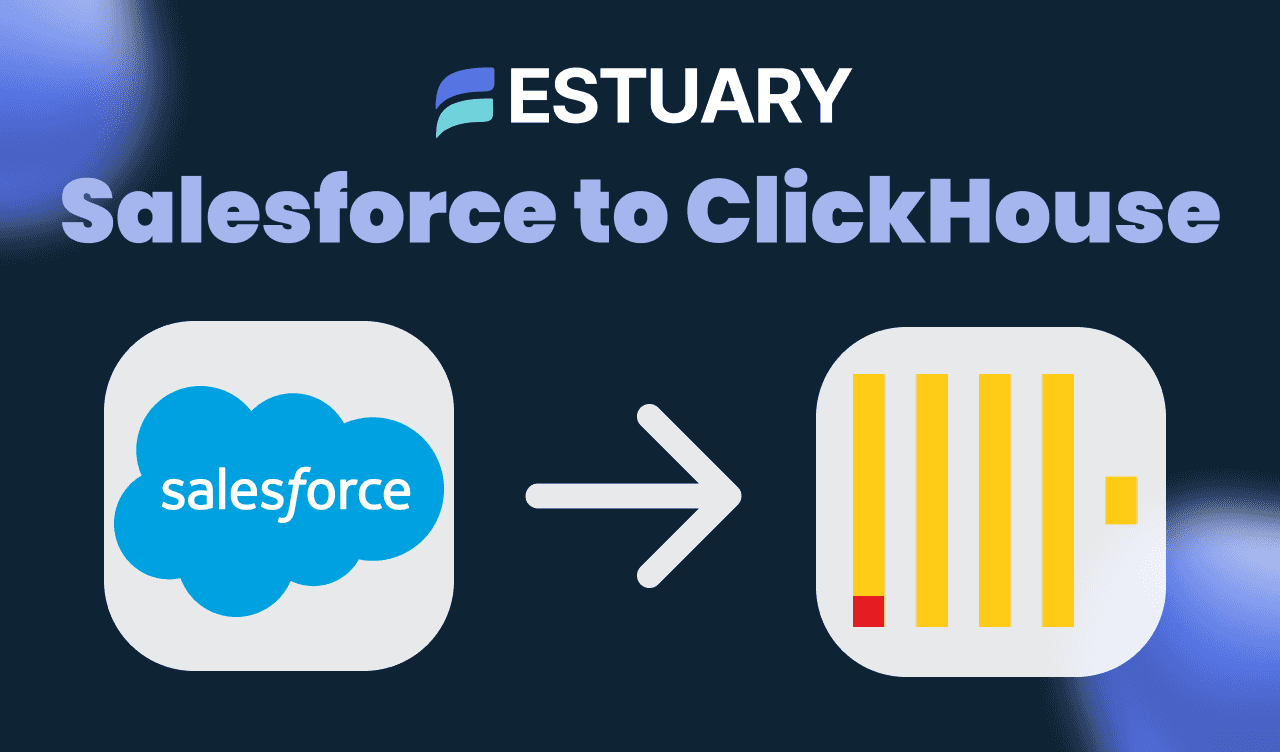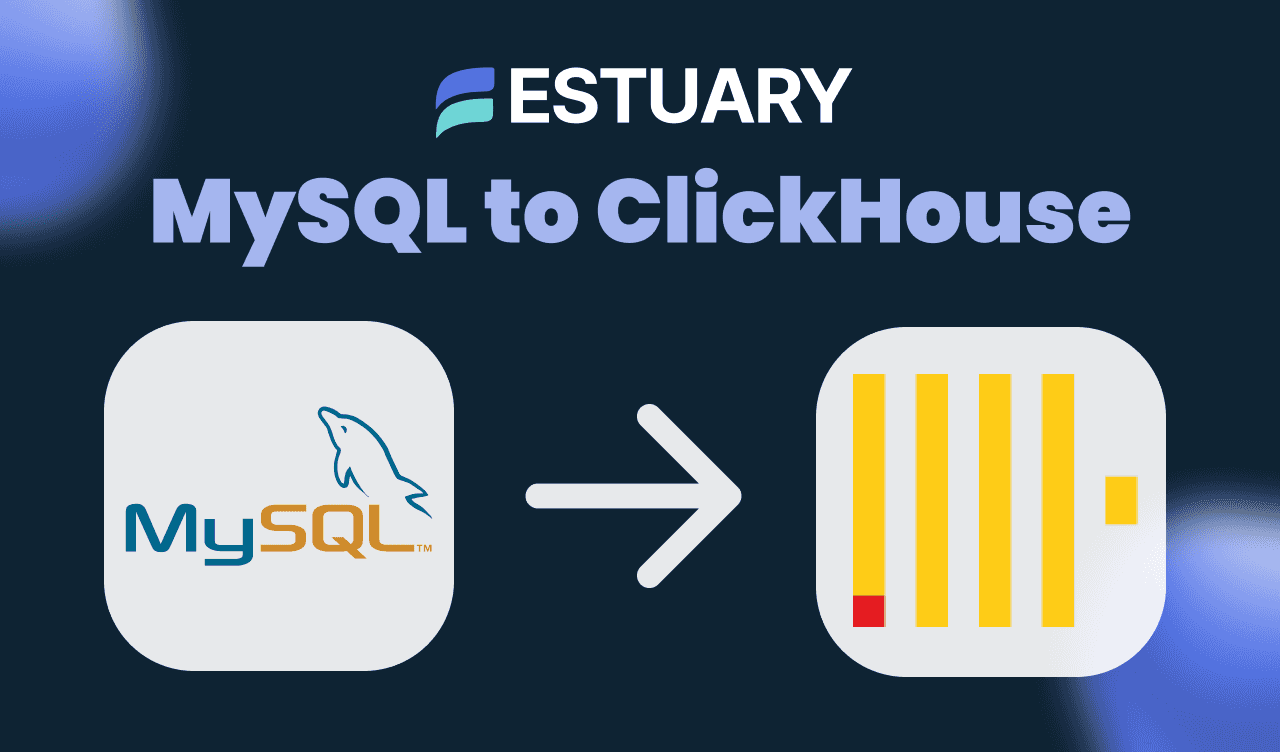
Businesses large and small rely on data-driven insights to inform decisions. As data grows in volume and complexity, choosing the right analytical database is crucial. ClickHouse and Snowflake are two popular OLAP database systems often compared for analytics workloads, but they take very different approaches.
In this OLAP databases comparison, we’ll explore ClickHouse vs. Snowflake in depth, looking at their architecture, storage, performance, use cases, pricing, and ecosystem integrations to help you determine which best suits your needs.
TL;DR: ClickHouse vs. Snowflake in a Nutshell
ClickHouse is an open-source, real-time OLAP database built for ultra-fast queries and massive data ingestion. It is ideal for operational analytics, observability, and high-frequency workloads.
Snowflake is a fully managed cloud data warehouse focused on ease of use, scalability, and collaboration. It is perfect for enterprise BI, ELT, and cross-team analytics.
- ClickHouse: Blazing performance, flexible deployment, low cost, best for real-time analytics.
- Snowflake: Cloud-native simplicity, strong security, data sharing, and elastic compute scaling.
- Best of both: Use ClickHouse for instant insights and Snowflake for long-term warehousing and governance.
- With Estuary: Seamlessly sync and stream data between both in real time with no batch jobs or lag.
ClickHouse Overview – Real-Time Analytics DBMS
ClickHouse is an open-source, column-oriented SQL database management system optimized for online analytical processing (OLAP) and real-time analytics. Originally developed at Yandex, ClickHouse is designed for blazing-fast queries on large data sets, offering millisecond-level response times on billions of rows. It achieves this via features like columnar storage, aggressive data compression, sparse indexing, and vectorized query execution. ClickHouse can be deployed on-premises or in the cloud, and a managed service (ClickHouse Cloud) is available for those who want a hosted solution.
Key Features of ClickHouse:
- Columnar Storage & Compression: Data is stored by columns with efficient compression codecs, which reduces I/O and accelerates scans. This makes analytic queries (like sum, count, aggregates) very fast since only the needed columns are read from disk.
- Indexing & Query Optimization: ClickHouse uses primary indexes (often sparse indexes) and can utilize data skipping indexes (like min-max values per data part) to prune unnecessary data. It does not use traditional B-tree indexes for every column, but its storage engine and partitioning schemes allow fast lookups on sorted keys.
- Distributed and Real-Time Processing: ClickHouse supports clustering and sharding of data across multiple nodes for horizontal scale-out. It can ingest data continuously and execute distributed queries in parallel across shards.
- Flexibility: Being open-source, ClickHouse can run on commodity hardware or cloud VMs, and it supports various client drivers (HTTP, JDBC/ODBC, etc.). It now also offers ClickHouse Cloud, which introduces decoupled storage (using S3) and compute separation options for more elastic scaling (similar to Snowflake’s approach).
Snowflake Overview – Cloud Data Warehouse
Snowflake is a fully managed cloud-native data warehouse and analytics platform. It is a proprietary SaaS platform known for its ease of use, scalability, and broad SQL support. Snowflake’s distinctive architecture cleanly separates storage and compute: data is stored in cloud object storage (e.g. S3, Azure Blob) and compute is handled by independent clusters called “virtual warehouses.” This multi-cluster shared data architecture allows Snowflake to scale transparently and handle many concurrent users by adding compute resources without duplicating data. Snowflake is not open-source; it’s offered as a cross-cloud service with a usage-based pricing model.
Key Features of Snowflake:
- Fully Managed Service: Snowflake abstracts away nearly all infrastructure management. Users don’t worry about installing software, replication, or tuning disk formats – it’s all handled by Snowflake. This makes it very appealing to teams that want a “set and forget” data warehouse that automatically optimizes and scales.
- Standard SQL and Beyond: Snowflake supports ANSI SQL for querying and managing data, and it offers extensions for semi-structured data with the VARIANT type. It also allows user-defined functions in Java, Python, etc., and supports tasks and stored procedures.
- Virtual Warehouses: Compute clusters in Snowflake can be sized up or down on demand (from X-Small to 4XL, etc.) and can even automatically suspend when idle to save cost. Multiple warehouses can query the same data concurrently. This means one team can run heavy ETL in one warehouse while another team runs BI queries in another, without contention – a key to Snowflake’s high concurrency support (up to 8 queries per warehouse at a time by default, with the ability to auto-scale clusters for more concurrency).
- Data Sharing and Collaboration: Snowflake has built-in secure data sharing, letting you share live data with other Snowflake accounts or even the public (via the Snowflake Data Marketplace). This is a unique feature for multi-organization analytics.
- Automatic Optimization: Snowflake doesn’t require manual index tuning. Instead, it uses techniques like micro-partitioning and automatic metadata statistics to prune data. It also has a result cache and a query compilation engine to speed up repetitive queries. For specific point lookup use cases, Snowflake offers an optional Search Optimization Service (essentially creating hidden indexes) and clustering keys to improve performance – though these features can increase cost if used.
ClickHouse vs Snowflake: A Complete Side-by-Side Breakdown
See how ClickHouse and Snowflake differ across architecture, indexing, ingestion, and cost. Use this table to quickly assess which OLAP platform meets your needs.
| Feature | ClickHouse | Snowflake |
| Type | Open-source OLAP DB | Fully managed cloud data warehouse |
| Architecture | Monolithic (with decoupled storage in Cloud) | Decoupled compute and storage |
| Hosting Options | On-prem, cloud, or ClickHouse Cloud | SaaS-only (AWS, Azure, GCP) |
| Query Performance | Sub-second latency; ideal for real-time OLAP | High throughput; optimized for large-scale queries |
| Indexing | Sparse indexes, skip indexes, materialized views | Metadata pruning, clustering keys, optional indexing |
| Data Ingestion | Real-time via Kafka, ClickPipes, or direct API | Near real-time via Snowpipe, or batch ingest |
| Concurrency | Engine-level; up to 1000+ queries per replica | Virtual warehouses; ~8 queries/warehouse, autoscaling |
| Schema Support | Strict schema; supports evolution via configs | Flexible schema with VARIANT for semi-structured data |
| Integration Ecosystem | Superset, Metabase, Kafka, dbt, HTTP API, etc. | Tableau, PowerBI, Fivetran, Looker, dbt Cloud, etc. |
| Best Use Cases | Real-time dashboards, IoT, observability, ML feature stores | Centralized BI, ELT, cross-org data sharing, reporting |
| Pricing Model | Free (self-hosted) or usage-based via ClickHouse Cloud | Consumption-based (credits for compute + storage) |
| Cost Efficiency | High-optimized for always-on, high-ingest workloads | Elastic, but can get costly at scale |
| Vendor Lock-In | None - fully open-source | Proprietary, vendor-locked |
Architecture: ClickHouse vs Snowflake
When evaluating architectural differences between ClickHouse and Snowflake, consider the following:
- Storage:
Snowflake uses a decoupled architecture, separating compute from storage for effortless scaling across AWS, Azure, and GCP.
ClickHouse traditionally uses local disk, but ClickHouse Cloud now supports object storage (like S3), enabling a similar separation of concerns. - Deployment Flexibility:
Snowflake is a fully managed SaaS—you don’t handle infrastructure.
ClickHouse offers more flexibility: run it on-premises, in the cloud, or use ClickHouse Cloud for managed deployments.
Performance and Query: Speed, Indexing & Concurrency
Understanding how each system performs under pressure is critical in the ClickHouse vs Snowflake decision:
- Indexing:
Snowflake skips traditional indexes in favor of metadata pruning and clustering keys, with optional Search Optimization Service.
ClickHouse offers sparse indexing, skip indexes, and full support for materialized views, making it ideal for low-latency lookups. - Compute Tuning & Concurrency:
Snowflake automatically manages compute with virtual warehouses, offering elastic concurrency and caching.
ClickHouse handles concurrency at the engine level, supporting up to 1000 queries per replica with blazing-fast execution via vectorized processing.
Data Storage and Format
Both Snowflake and ClickHouse store data in a columnar format, but their approaches differ in compression and indexing:
- Compression & Efficiency:
ClickHouse offers customizable compression (e.g., LZ4, ZSTD), achieving up to 38% better compression than Snowflake in benchmarks.
Snowflake uses automated compression and micro-partitions, optimizing for parallel reads and metadata pruning. - Indexing & Materialized Views:
ClickHouse supports primary keys, skip indexes, and materialized views out-of-the-box.
Snowflake avoids traditional indexes but allows clustering keys and search optimization (enterprise feature), though it may add cost.
Use Cases: When to Choose ClickHouse vs Snowflake
Both platforms excel at analytical workloads, but their sweet spots differ significantly. Here's where each shines:
Real-Time Analytics & Observability → ClickHouse
ClickHouse is engineered for real-time performance and high-throughput ingestion, making it ideal for:
- Use Cases:
Product analytics, observability (logs, traces, metrics), IoT telemetry, and machine-generated data. - Why It Wins:
Sub-second query latency, blazing-fast aggregations, and ingestion rates exceeding 100K+ events/sec. Ideal for dashboards and time-series workloads.
Enterprise BI & Unified Warehousing → Snowflake
Snowflake is purpose-built for enterprise-scale analytics and collaboration across teams.
- Use Cases:
BI reporting, ELT pipelines, ad-hoc data science, semi-structured data processing, and secure data sharing. - Why It Wins:
Fully managed, highly scalable, supports massive concurrency, and enables seamless cross-org collaboration via data sharing.
Why Choose Snowflake?
Snowflake’s cloud-native architecture and ecosystem make it a favorite for enterprises prioritizing simplicity, security, and scale.
1. Diverse Workloads & Multi-User Teams
Supports traditional BI, ad-hoc SQL, data science pipelines, and even machine learning — all within one platform.
2. Seamless Data Sharing
Enables secure, real-time data collaboration with other Snowflake accounts or external stakeholders — no duplication required.
3. Minimal Maintenance & Strong Security
Snowflake handles clustering, backups, encryption, and tuning behind the scenes. It’s certified for compliance-heavy industries.
4. Support for Semi-Structured Data
Query JSON, Parquet, Avro, XML natively using SQL, eliminating the need for extra NoSQL or Hadoop systems.
5. Rich Ecosystem & Tooling
Snowflake integrates natively with major tools like Tableau, PowerBI, Fivetran, Looker, and offers one of the largest cloud data marketplaces.
Why Choose ClickHouse?
ClickHouse offers speed, control, and cost-efficiency — perfect for teams that want deep customization and real-time analytics.
1. Real-Time, Interactive Analytics
Designed for ultra-low-latency. Ideal for powering user-facing dashboards, monitoring systems, or product analytics at massive scale.
2. High-Ingest, High-Volume Streams
Built to keep up with millions of rows/sec ingestion — ideal for logs, metrics, IoT streams, and raw telemetry.
3. Cost Efficiency at Scale
Self-hosted ClickHouse is open-source and free. Even ClickHouse Cloud offers 3–5× cost savings compared to Snowflake for similar performance (based on ClickHouse’s benchmarks).
4. Customization & Extensibility
Tune your database like a performance engine. Use custom table engines, UDFs, or embed ClickHouse within your app. It’s flexible and developer-friendly.
5. ML-Ready & AI-Optimized
Support for arrays, vector indexes, and fast feature store access make it a great fit for ML pipelines and real-time inference workloads.
Pricing and Cost Considerations
Pricing is often the deciding factor between ClickHouse and Snowflake — especially at scale. Here's how they compare:
Snowflake Pricing
Snowflake follows a usage-based pricing model with charges based on compute, storage, and features.
- Compute (Credits):
Virtual warehouses are billed by the second (min. 60 sec). Each size (S/M/L) consumes more credits per hour — e.g., 1 credit/hour for Small, 4 for Large.
Credits = CPU + RAM billing units. - Storage:
Billed per TB/month. Also charges for egress, fail-safe, and longer-term backups. - Feature Add-ons:
Using multi-cluster warehouses, search optimization, or materialized views (Enterprise+) can significantly increase costs. - Pricing Tiers:
Standard, Enterprise, Business Critical, and VPS tiers — each unlocking more features.
Free trial: $400 in credits to start.
Takeaway:
- Great for elastic, bursty workloads.
- Can get expensive for high-frequency or 24/7 usage.
ClickHouse Pricing
ClickHouse offers flexible cost models: self-hosted (free software) or managed cloud (ClickHouse Cloud).
- Self-Hosted (Open Source):
No licensing fees. You only pay for infrastructure (VMs, storage) and engineering time. - ClickHouse Cloud:
Pricing based on vCPUs, memory, and storage. Tiers include:- Development: Light workloads (up to 1TB).
- Production: High-resilience, mission-critical usage.
- Enterprise (Dedicated): For lowest-latency, dedicated hardware.
- Predictable Cost:
Unlike Snowflake’s credits, ClickHouse Cloud offers more transparent monthly pricing per instance/resources.
Takeaway:
- Highly cost-effective for constant, high-ingestion workloads.
- Ideal for teams with in-house ops expertise.
Streamline Real-Time Data Movement with Estuary
Whether you’re working with ClickHouse, Snowflake, or both — keeping your data synchronized across platforms is key to unlocking analytics at scale. Estuary lets you do just that with real-time, fault-tolerant pipelines — without writing a line of custom glue code.
Capture Changes from Source Systems
Estuary’s capture connectors pull data from sources like PostgreSQL, MySQL, SQL Server, MongoDB, and more using change data capture (CDC) — detecting inserts, updates, and deletes in near real-time.
You can then materialize that data into either ClickHouse or Snowflake, maintaining freshness across analytical systems.
Real-Time Streaming Into ClickHouse
Estuary integrates with ClickHouse using its Kafka-compatible Dekaf connector:
- Flow streams your captured data to Kafka topics.
- ClickHouse’s Kafka Engine or ClickPipes pulls this data into tables.
- You don’t need to run or manage Kafka — Estuary handles the streaming layer.
Learn more: ClickHouse Materialization Connector
Snowflake: Ingest, Archive, and Analyze
Estuary supports bi-directional integration with Snowflake:
- Materialization Connector: Stream Flow collections into Snowflake tables continuously, optionally using Snowpipe-like batch inserts for efficiency.
- Capture Connector: Periodically poll Snowflake tables (default: every 5 minutes) to extract new rows into Flow collections.
Additional Key Capabilities
- Backfills & Replay - Rebuild downstream systems or recover from outages without data loss using Estuary’s built-in recovery and backfill support.
- Schema Evolution - Flow tracks and adapts to schema changes automatically — no pipeline breakage or manual mapping.
- Streaming-first ETL/ELT - Define transformations declaratively, and Flow applies them as data streams through — with no intermediate batch step required.
Real-World Examples
- Capture CDC from Postgres Stream to ClickHouse for sub-second operational dashboards.
- Ingest Shopify & Stripe events → Materialize to Snowflake for centralized reporting.
- Mirror processed Snowflake data → ClickHouse for ultra-fast embedded analytics.
Want to sync data between ClickHouse and Snowflake with zero batch jobs and sub-minute latency? Try Estuary for free.
Conclusion: ClickHouse vs Snowflake
When it comes to modern analytics, ClickHouse vs. Snowflake isn’t always a binary decision. In fact, many teams use them together, leveraging ClickHouse for real-time, high-speed analytics and Snowflake for enterprise-scale BI, governance, and long-term warehousing.
By understanding their differences in architecture, performance, cost, and use cases, you can design a data stack that’s tailored to your exact needs.
And with Estuary, integrating these systems is seamless:
- Stream raw events into ClickHouse for ultra-fast analysis
- Replicate key datasets to Snowflake for long-term insights
- Keep them in sync — automatically, continuously, and reliably
Whether you choose one or both, Estuary’s streaming-first, CDC-powered platform helps you build high-performance pipelines without the complexity.
FAQs
Can I use both ClickHouse and Snowflake together?
Which offers better cost efficiency: ClickHouse or Snowflake?
Is ClickHouse vendor-locked?

About the author
With over 15 years in data engineering, a seasoned expert in driving growth for early-stage data companies, focusing on strategies that attract customers and users. Extensive writing provides insights to help companies scale efficiently and effectively in an evolving data landscape.














